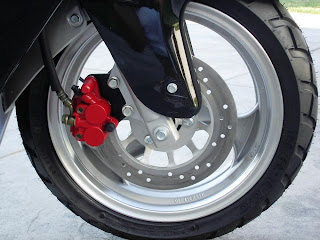I have been speaking to a lot of customers lately regarding their brakes and how to care for them, use them and ultimately get the best performance out of what has been fitted to their scooter or bike.
Scooters and motorcycles generally use two different types of brakes or more commonly a combination of the two;
Example of the inside of a drum brake
The first and most common is the Drum Brake it is very simple and very effective within limits such as cost of production, wet or dry operation and size and weight of machine. Effectively the drum brake as suggested by the name is a pair of matching (or slightly smaller diameter) shoes which are fixed to the front fork or rear engine case/swingarm, the “drum” is fixed to the wheel hub and sits over but away from the shoes, when the brake lever is applied a small flat cam lever rotates forcing the shoes outwards and against the inside of the drum creating friction and ultimately slowing the rotational speed of the wheel until completely stopped or under light applications until the desired speed is reached.
Disc brake on the front wheel of a scooter
Disc Brakes work under a similar theory. In place of the drum is a flat disc of usually 3-5mm thickness which is attached to the wheel hub with the calliper being attached to the fork or engine casing/swingarm. When the lever is actuated it forces a pair of brake/friction pads hard up against the disc and creating the same stopping effect as the shoes do in the drum brake.
Both disc and drum brakes have some inherent advantages and disadvantages. Drum brakes are very easy and cheap to manufacture and work very effectively on a lightweight machine in dry conditions. The linkage system can be very simple and pretty much trouble free as it is usually a direct mechanical linkage or cable so very little to go wrong. The down side is once (as any postie will know about this if they rode the old P Model CT110) the drum has worn past its serviceable limit, ie; the diameter has worn past the outer diameter, there is very little to be done except replace the drum. The problem is it is usually integral with the rest of the wheel and therefore not a cheap exercise. Most wheels will go through at least 5-6 sets of shoes before this ever occurs and very possibly will outlast the rest of the bike. Drum brakes are also prone to squeaking. This is caused by a build up of all the old friction and drum material within what is a mostly closed environment getting caught between the two components. Brake squeak is pretty much an aesthetic annoyance more so than a safety issue. The main downside to drum brakes is that should they become totally immersed or have water get into the contact areas your braking performance is significantly reduced (yet again ask any postie or old school dirt bike rider about stopping after a creek crossing).
Disc brakes have classically always been more expensive to produce mainly due to the complex mechanics of the hydraulic actuation. Unlike the drum brake the pads within the calliper are forced against the rotating disc via a high pressure pump or master cylinder as it is known. This inturn forces the piston/s inside the calliper against the pad and creates massive clamping pressures and a much stronger stopping action. Because all the friction surfaces are mainly exposed cooling is far more efficient (have a close look at the wheels next time you see a V8 supercar or F1 car in full deceleration in a race-they glow red hot and in fact rely on this massive heat to work properly) and again due to the exposed components any water/mud or contaminates splashed against the disc are very quickly dissipated by the wiping action of the leading edge of the brake pad. Most disc brakes will still work very well even totally immersed. If you look after the hydraulics with a fluid flush every 1-2 years the cost of replacement discs and pads is considerably cheaper as they can be replaced independently of the wheel/hub.
The best way to care for the standard brakes on your scooter is to always ensure your adjustment on drum brakes is up to spec. Don’t wait till the lever is hitting the bar before adjusting or getting a mechanic to do so. Try to avoid getting foreign material in to the hub area - stay away from extreme environments. Most scooters are not dirt bikes or submarines! If you have a new set of shoes fitted and half of your adjustment is gone before correct adjustment is achieved this is an indicator of worn drum area.
Disc brakes will withstand harder environments over drum brakes, but as suggested previously this not a licence to go off-roading. Brake fluid is hygroscopic (it attracts water out of the atmosphere) and therefore must be flushed at least every 18 months to two years. Keep an eye (or your mechanic should if you get regular services) on the thickness of the brake pad material and change them when they get low- you do not want metal to metal! This destroys the disc and these are generally not cheap.
If you’re worried about your brakes, or want them checked out and serviced, book into your local scooter mechanic asap. Afterall, they’re high up on the list of things you want to be reliable!









